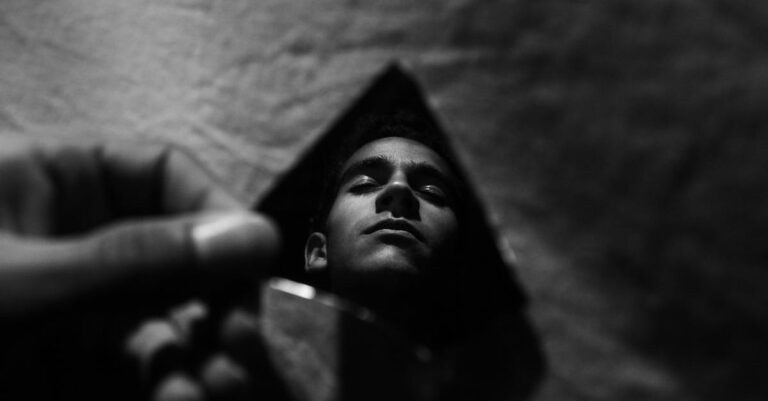Dr. Voss adjusted the magnifying lens over her left eye, the sterile hum of the lab machines a familiar drone against her skull. The man on the table—subject 237—had been here for three weeks, a silent enigma wrapped in hospital linen. No name, no history, only a file labeled *UNIDENTIFIED*. His vitals were stable, his brain activity… peculiar. The monitors flickered with patterns that didn’t match any known neural signature. She leaned closer, her breath fogging the glass of the observation window. “You’re not asleep,” she murmured, more to herself than to him. The machine beside her beeped sharply, a jagged spike on the EEG. She froze. The man’s fingers twitched. Just once. A reflex, she told herself. But the spike had matched the rhythm of her own thoughts—the ones she’d just formed.
The lab’s fluorescent lights buzzed overhead, casting a pale glare over the steel tables and blinking monitors. Voss stepped back, her pulse a low thrum in her ears. She’d seen anomalies before—patients with rare neurological conditions, brain injuries that defied classification—but this was different. The data didn’t lie. The man’s brain wasn’t just reacting to external stimuli; it was *responding* to her. She reached for the tablet on the counter, swiping through the latest scans. The patterns were shifting, almost… *learning*. A jagged line of activity pulsed near the temporal lobe, a region associated with memory. Her fingers hovered over the screen. What if this wasn’t a coma? What if he was waiting?
That night, she stayed late, the lab empty except for the rhythmic sigh of the air vent. The man’s eyes were open now, fixed on the ceiling, but there was no awareness in them—just a hollow stillness. Voss sat at her desk, the glow of her monitor casting shadows across her face. She typed a single word: *Remember*. The machine’s screen flickered. A new pattern emerged, a slow pulse that mirrored her own brainwaves. She leaned forward, heart pounding. This wasn’t a coincidence. The man’s brain was *echoing* hers. But how? And why?
The next morning, she found a photograph in her desk drawer—a faded black-and-white image of a woman with the same sharp cheekbones and dark eyes as her own. The back was scribbled with a date she didn’t recognize and a single word: *Project Lumen*. Her hands trembled. She’d never seen this before. The lab’s door creaked open, and she snapped the drawer shut. Dr. Rourke stood in the threshold, his expression unreadable. “You’re working late,” he said, but his eyes lingered on the photo. Voss straightened, feigning nonchalance. “Just going over the data. Subject 237’s readings are… unusual.” Rourke’s gaze didn’t waver. “You should take a break. Stress isn’t good for the mind.” She forced a smile. “I’ll keep that in mind.” As he left, she stared at the photo, the weight of it settling in her chest.
Over the next week, the patterns grew more complex. Voss began to see fragments—memories not her own. A hospital room, sterile and cold. A man with a scar across his jaw, whispering something she couldn’t hear. A flash of light, then darkness. She jolted awake in her apartment, her hands gripping the edge of the bed. The memories felt real, too real. She poured over the files again, searching for connections. Then she found it: a series of experiments listed under *Project Lumen*, all dated years before she’d started working at the institute. The subjects were all women, their names redacted, their files filled with cryptic notes about “cognitive synchronization” and “neural extraction.” Her stomach churned. This wasn’t an accident. Someone had been using these patients—using *her*—to steal memories. But why? And who?
The breakthrough came on a rainy Tuesday. Voss was monitoring the man when a new pattern emerged—a rapid, chaotic sequence that mirrored her own thoughts. She closed her eyes, focusing on a memory: her mother’s voice, soft and distant, saying “stay safe.” The machine’s screen lit up with the same erratic pulse. She opened her eyes, breath shallow. He was *copying* her. But how? And why? She reached for the tablet, typing a question: *Who are you?* The response came instantly—a jagged line of activity that formed a word she didn’t recognize. Then, a second word: *Help.*
That night, she couldn’t sleep. The lab felt different, the air heavier, as if the walls were listening. She sat at her desk, the photo of the woman in front of her, and traced the edges with her finger. The memory of the hospital room returned, clearer this time. She was there, standing beside a bed where a woman lay motionless. Her own face stared back at her from the mirror on the wall. The realization hit like a punch to the gut. This wasn’t just an experiment. It was a replacement. She wasn’t the first. And she wouldn’t be the last.
The next morning, she confronted Rourke. “What’s Project Lumen?” His face remained impassive, but his hands tightened on the file in front of him. “You shouldn’t be asking that question,” he said, but there was a flicker of something in his eyes—fear, maybe. Voss didn’t back down. “I’ve seen the files. I know what you’re doing. You’re not healing these people. You’re taking their memories.” Rourke’s jaw clenched. “You don’t understand the stakes. This isn’t about theft. It’s about survival.” She stepped closer, her voice steady. “Then why hide it? Why keep me in the dark?” He didn’t answer. The silence stretched between them, thick and unspoken.
That evening, she returned to the lab, her heart pounding. The man on the table was awake now, his eyes open, fixed on her. She hesitated, then stepped closer. “You’re not a patient,” she said softly. “You’re a mirror.” His lips moved, but no sound came out. She reached for the tablet and typed: *I know what they did to you.* A pause. Then, a slow pulse on the screen. *Thank you.*
The next morning, Voss stood in the hallway outside the lab, her hands shaking. The files were gone, erased from the system. Rourke’s office was empty. She had two choices: expose the truth and risk everything, or vanish before they found her. She thought of the woman in the photo, of the memories that weren’t hers, of the man who had seen her as clearly as she saw him. She turned on her heel and walked out, the weight of it settling in her chest. The story wasn’t over. But for now, she was free.
The final scene played out in her mind as she stepped onto the street. The rain had stopped, the air fresh and sharp. She didn’t look back. The lab, the memories, the woman in the photo—they were all part of a past she couldn’t reclaim. But she was still here, still *herself*. And that was enough.


